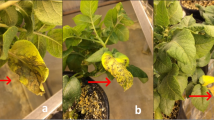Abstract
SeveralSolatium tuberosum clones were tested for resistance to the reniform nematode,Rotylenchulus reniformis. Commercial cultivars La Rouge and possibly Red La Soda had high levels of resistance to the reniform nematode.R. reniformis resistance was found to exist independently of the H1, H2, or H3 genes for resistance to races of potato cyst nematodes,Globodera rostochiensis andG. pallida. In addition to reniform nematode resistance, B7642-2, B7154-8 and B7680-6 contained the H1 gene and breeding linePI 377741 contains the H1 and H2 gene for potato cyst nematode resistance. Over a three month period reniform nematode counts were significantly lower in pots where resistant varieties were grown.
Resumen
Varios clones deSolanum tuberosum fueron probados para determinar su grado de resistencia al nemátodo de riñón,Rotylenchulus reniformis. Cultivares comerciales La Rouge y posiblemente Red La Soda mostraron un alto grado de resistencia al nemátodo de riñón. Se encontró que la resistencia al nemátodo reniforme es independiente de los genes de resistencia H1, H2 o H3, al nemátodo de quiste de la papa. Ademas de resistencia al nemátodo de riñón, los clones B7642-2, B7154-8 y B7680-6 tienen el gene H1 y la línea PI 37741 contiene el gene H1 y H2 para resistencia al nemátodo de quiste de la papa. Durante un período de tres meses, los contajes de nemátodos de riñón fueron significativamente más bajos en macetas donde se sembraron variedades resistentes.
Similar content being viewed by others
Literature Cited
Abdel-Rahman, T. B., D. M. Elgindi, and B. A. Oteifa. 1974. Efficacy of certain systemic pesticides in the control of root-knot and reniform nematodes of potato. Plant Dis Rep 58:517–520.
Birchfield, W., C. Williams, E. E. Hartwig, and L. R. Brister. 1971. Reniform nematode resistance in soybeans. Plant Dis Rep 55: 1043–1045.
Fuller, J. M., and H. W. Howard. 1974. Breeding for resistance to the white potato cyst-nematode,Heterodera pallida. Ann appl Biol 77:121–128.
Howard, H. W., and J. M. Fuller. 1971. Resistance to the cream and white potato cyst nematode. Plant Pathol 20:32–35.
Kort, J., H. Ross, H. J. Rumpenhorst, and A. R. Stone. 1977. An international scheme for identifying and classifying pathotypes of potato cyst-nematodesGlobodera rostochiensis andG. pallida. Nematologica 23:333–339.
Linford, M. B., and F. Yap. 1940. Some host plants of the reniform nematode in Hawaii. Proc Helminthol Soc Wash 7:42–44.
Parrott, D. M., and D. L. Trudgill. 1972. The resistance of hybrids ofSolanum tuberosum spp.andigena andS. multidissectum toHeterodera rostochiensis pathotype E. Plant Pathol 21:86–88.
Peterson, L. C., and R. L. Plaisted. 1966. Peconic, a new potato variety resistant to the golden nematode. Am Potato J 43:450–452.
Plaisted, R. L., et al. 1973. Hudson: A high yielding variety resistant to golden nematode. Am Potato J 50:212–215.
Rebois, R. V., B. J. Eldridge, J. M. Good, and A. K. Stoner. 1973. Tomato resistance and susceptibility to the reniform nematode. Plant Dis Rep 57:169–172.
Rebois, R.V., B.J. Eldridge, and R.E. Webb, 1974. Reniform nematode effect on tuber yields of four potato cultivars under greenhouse conditions. J Nematol 6:149–159 (Abstr.).
Rebois, R. V., B. J. Eldridge, and R. E. Webb. 1978.Rotylenchulus reniformis parasitism of potatoes and its effect on yields. Plant Dis Rep 62:520–523.
Rebois, R. V., J. M. Epps, and E. E. Hartwig. 1970. Correlation of resistance in soybeans toHeterodera glycines andRotylenchulus reniformis. Phytopathology 60:695–700.
Rebois, R. V., W. C. Johnson, and E. J. Cairns. 1968. Resistance in soybeans,Glycine max L. Merr., to the reniform nematode. Crop Sci 8:394–395.
Rebois, R. V., P. A. Madden, and B. J. Eldridge. 1975. Some ultrastructural changes induced in resistant and susceptible soybean roots following infection byRotylenchulus reniformis. J Nematol 7:122–139.
Rebois, R. V., A. E. Steele, A. K. Stoner, and B. J. Eldridge. 1977. A gene for resistance toRotylenchulus reniformis in tomato, and a possible correlation with resistance toHeterodera schachtii. J Nematol 9:280–281.
Rebois, R. V., R. E. Webb, and B. J. Eldridge. 1977. Reniformnematode, Rotylenchulus reniformis, resistance in potatoes,Solanum tuberosum. Proc Am Phytopathol Soc 4:218 (Abstr.).
Swarup, G., R. P. Nath, and C. L. Sethi. 1967. The plant parasitic nematode genusRotylenchulus in India. Indian Phytopathol 20:118–123.
Verma, S. K., and S. K. Prasad. 1969. The reniform nematode,Rotylenchulus reniformis Linford and Oliveira, 1940. I — Bioecological studies. Indian J Entomol 31:36–47.
Author information
Authors and Affiliations
Additional information
An erratum to this article is available at http://dx.doi.org/10.1007/BF02855353.
Rights and permissions
About this article
Cite this article
Rebois, R.V., Webb, R.E. Reniform nematode resistance in potato clones. American Potato Journal 56, 313–319 (1979). https://doi.org/10.1007/BF02855600
Received:
Issue Date:
DOI: https://doi.org/10.1007/BF02855600




